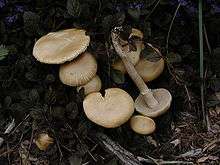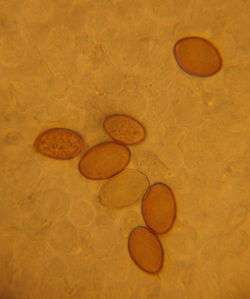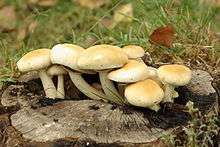Agrocybe
Agrocybe is a genus of mushrooms in the family Strophariaceae (previously placed in the Bolbitiaceae). The genus has a widespread distribution, and contains about 100 species.[1]
| Agrocybe | |
|---|---|
 | |
| Agrocybe praecox | |
| Scientific classification | |
| Kingdom: | Fungi |
| Division: | Basidiomycota |
| Class: | Agaricomycetes |
| Order: | Agaricales |
| Family: | Strophariaceae |
| Genus: | Agrocybe Fayod. |
| Type species | |
| Agrocybe praecox (Pers.) Fayod | |
Distribution
Mushroom cultivation began with the Romans and Greeks, who grew the small Agrocybe aegerita. The Romans believed that fungi fruited when lightning struck.[2] In Europe, toxic forms are not normally found, but Agrocybe molesta could be confused with poisonous white Agaricus species or with poisonous Amanita species.
The edible southern species Agrocybe aegerita is commonly known as the Poplar mushroom,[3] Chestnut mushroom or Velvet pioppino (Chinese: 茶樹菇). It is a white rot fungus and is a medium-sized agaric with a convex, almost flat, cap 3 to 10 cm in diameter. Underneath, it has numerous whitish radial plates adherent to the foot, later turning to a brownish-gray color, and light elliptic spores of 8-11 by 5-7 micrometres. The white fiber foot is generally curved, having a membraneous ring on the top part which promptly turns to tobacco color due to the falling spores.[3] When very young, its color may be reddish-brown and later turn to a light brown color, more ocher toward the center and whiter around its border. It grows in tufts on logs and holes in the poplars, and other trees of large leaves[3] It is cultivated and sold in Japan, Korea, Australia and China. It is an important valuable source possessing varieties of bioactive secondary metabolites such as indole derivatives with free radical scavenging activity, cylindan with anticancer activity, and also agrocybenine with antifungal activity.[4]
Agrocybe farinacea of Japan, a species closely related to Agrocybe putaminum,[5] has been reported to contain the hallucinogen psilocybin,[6] however there has been no recent chemical analysis carried out on this mushroom, nor any modern reports of psychoactivity.
Selected list of species

- Agrocybe acericola (maple agrocybe)
- Agrocybe aegerita
- Agrocybe allocystis
- Agrocybe amara
- Agrocybe arvalis
- Agrocybe dura
- Agrocybe erebia
- Agrocybe farinacea (possibly contains psilocybin)
- Agrocybe firma
- Agrocybe lazoi
- Agrocybe ludoviciana[7]
- Agrocybe molesta
- Agrocybe paludosa
- Agrocybe pediades (common lawn mushroom)
- Agrocybe praecox (common and widespread)
- Agrocybe procera
- Agrocybe putaminum
- Agrocybe retigera
- Agrocybe rivulosa
- Agrocybe semiorbicularis
- Agrocybe sororia
- Agrocybe vervacti
- Agrocybe viscosa
See also
- List of psilocybin mushrooms
- Psilocybin mushroom
References
- Kirk PM, Cannon PF, Minter DW, Stalpers JA (2008). Dictionary of the Fungi (10th ed.). Wallingford: CABI. p. 14. ISBN 978-0-85199-826-8.
- Clifford A. Wright, Mediterranean vegetables: a cook's ABC of vegetables and their preparation, pg. 229, Harvard Common Press (2001), ISBN 1-55832-196-9
- Mariano García Rollán, Cultivo de setas y trufas, pg. 167, MUNDI-PRENSA (2007), ISBN 84-8476-316-1 (in Spanish)
- Jian-Jiang Zhong, Feng-Wu Bai, Wei Zhang, Biotechnology in China I: From Bioreaction to Bioseparation and Bioremediation, vol. 1, pag. 102, Springer (2009), ISBN 3-540-88414-9
- Rijksherbarium, Blumea: Supplement, vol. 4, pg. 142, Journal of Plant Taxonomy and Geography, Netherlands (1952)
- Jonathan Ott, Albert Hofmann, Pharmacotheon: Entheogenic Drugs, Their Plant Sources and History, pg. 313, Natural Products Company (1993), ISBN 0-9614234-9-8
- Hausknecht A, Krisai-Greilhuber I, Voglmayr H (2004). "Type studies in North American species of Bolbitiaceae belonging to the genera Conocybe and Pholiotina". Österreichische Zeitschrift für Pilzkunde. 13: 153–235 (see pp. 180, 212).
